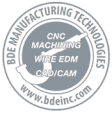Posted On: January 6, 2020
It’s no doubt that CNC businesses have to maintain a high-efficiency level to machine those difficult jobs with expected precision. Hence, CAD/CAM technology, which stands for computer-aided design & computer-aided manufacturing, is largely utilized today to support today’s high-speed machining process. CNC machining shops are reaping the benefits of CAM/CAD, as they together help improve time to market capabilities, and create precise dimensions. Most importantly, CAD-CAM can help a CNC machining shop to create toolpaths to turn complex designs into physical parts. If you are new to CNC machining, you may find the word toolpath confusing. In simpler terms, “Toolpath” is a series of coordinate locations that a cutting tool will follow in the machining process. There are different types of dynamic toolpaths that give the programmers the control and confidence to machine difficult jobs. Would you like to know about a few amongst the popular toolpaths? Read the post to know the answers.
Different Toolpaths for effective High-Speed Machining (HSM) process
The CAD/CAM is of no use, without the right toolpath. Hence, choosing the right toolpath is important for improving machining efficiency and productivity. The following are a few different types of toolpaths that are used to optimize CNC machining services.
1. Toolpath: Face
Uses: This toolpath helps achieve excellent finishing on the face of a part.
2. Toolpath: Constant Stepover
Uses: This toolpath lends consistent and regular looking finish to a part.
3. Toolpath: Pencil Milling
Uses: This toolpath takes care of the corners and concave areas of the part, and helps achieve an optimum surface finish.
4. Toolpath: Contour
Uses: This helps machine loops, open pockets, stick fonts, or saw cuts.
5. Toolpath: Horizontal Machining
Uses: This finishing strategy works for both flat as well as slope areas.
6. Toolpath: Rest Machining or Rest Roughing
Uses: This helps achieve intended roughing and fining using larger cutters and smaller cutters.
7. Toolpath: Chamfer
Uses: The toolpath strategy is employed for deburring and creating chamfers.
8. Toolpath: Fillet
Uses: This strategy utilizes a corner rounding tool, and helps create fillets.
9. Toolpath: Zig-zag Clearing
Uses: This toolpath is designed to optimize the straight-line motion of the cutter.
10. Toolpath: Spiral
Uses: This helps machine rounded shaped details efficiently.
11. Toolpath: 3D Plunge Roughing
Uses: This toolpath is designed to drill out material for the plunging motion.
12. Toolpath: Advanced Z Level Finishing
Uses: This 3D finishing toolpath helps machine the vertical surfaces of your part.
13. Toolpath: Pocket
Uses: This toolpath can be chosen for roughing or finishing pockets of a wide range of shapes and sizes.
14. Toolpath: Slot Mill
Uses: This toolpath is specifically designed to machine straight slots or arc slots.
15. Toolpath: Pencil
Uses: It can be chosen to clean up the inside corners on 3D projects.
Similar to the varied toolpaths listed above, there are several more that provide better ways to accommodate the needs of customers. CAD/CAM software will provide a variety of such toolpaths that can reduce cycle times and help your shop to achieve superior part finishes. Hence, understanding your toolpath types is extremely important as it imparts efficiency needed to machine any complicated part. Almost all the state-of-the-art CNC machine shops of today’s age like BDE Manufacturing Technologies (BDE), provide precision CNC machining and tool making solutions by best utilizing these varied toolpath strategies. The company caters to the requirements of semiconductors, marine, food, aerospace, military, and medical industries among others through its efficient CAD/CAM programming services.
Related Blog Post:
What are the Different Tool path Strategies for Optimizing CNC Machining? Read More
 info@bdeinc.com
info@bdeinc.com 866.262.6233
866.262.6233





